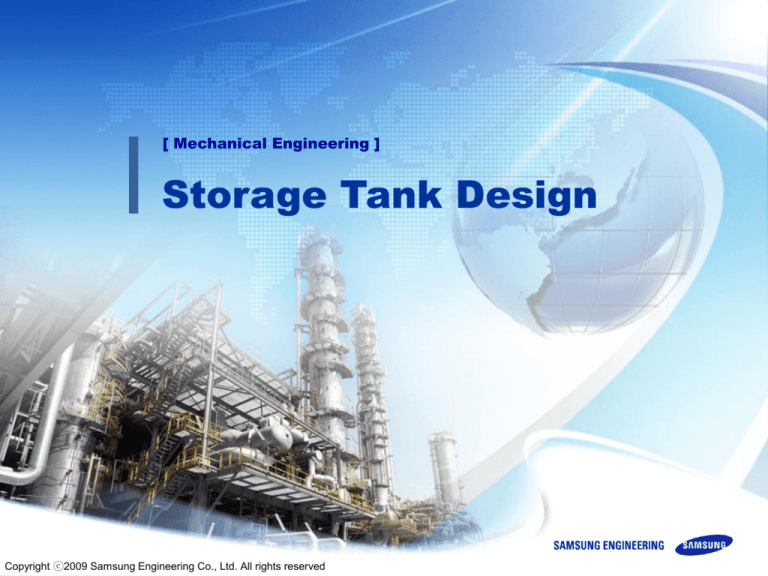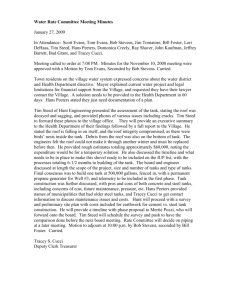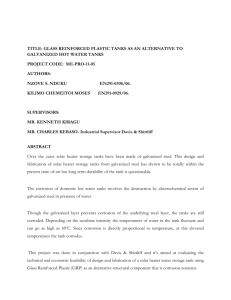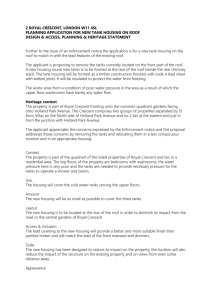
[ Mechanical Engineering ]
Storage Tank Design
Copyrightⓒ2009
ⓒ2009
Samsung
Engineering
Co.,
Ltd.
rights
reserved
Copyright
Samsung
Engineering
Co.,
Ltd.
AllAll
rights
reserved
1
Table of Contents
1.
Introduction
1) Tank classification
2) Shape of a tank / Type of a tank
2.
General Design of Tanks
1) General design considerations
2) Flat tank bottom
3) Shell
4) Opening
5) Wind girders
6) Roof
7) Foundation Loads
Copyright ⓒ2009 Samsung Engineering Co., Ltd. All rights reserved
2
Table of Contents
3.
Floating Roofs
1) External floating roof
2) Internal floating roof
4.
Other Design Considertations
1) Corrosion protection
2) Fire protection of Tanks
3) Tank Emissions
4) Tank Settlement
5.
Q&A
6. Practice I
7.
Practice II
Copyright ⓒ2009 Samsung Engineering Co., Ltd. All rights reserved
3
1. Introduction
A Storage Tank is a container, usually for holding liquids, sometimes
for compressed gases (gas tank). Storage tanks operate under no (or
very little) pressure, distinguishing them from pressure vessels.
Copyright ⓒ2009 Samsung Engineering Co., Ltd. All rights reserved
4
1. Introduction
1. Introduction
1) Tank Classification
a. Atmospheric tanks : Atm ~ 2.5 psig
- Usually operated at internal pressures slightly above atmospheric pressure
- The most common type of tank
b. Low-pressure tanks : 2.5 psig ~ 15 psig
c. High-pressure tanks (Pressure vessels) : 15 psig or above
- ASME Boiler and Pressure Vessel Code is one of the primary standards.
- ex) Sphere tanks
d. Underground storage
e. Refrigerated
Copyright ⓒ2009 Samsung Engineering Co., Ltd. All rights reserved
5
1. Introduction
2) Shape of a tank / Type of a tank
The vapor pressure of the substance stored or internal design pressure
is the broadest and most widely used method adopted by codes, standards,
and regulations. The vapor pressure determines the shape and
consequently, type of tank used.
Copyright ⓒ2009 Samsung Engineering Co., Ltd. All rights reserved
6
1. Introduction
a. Fixed-roof tanks
- Fixed roof tanks are typically designed for low internal pressures.
- Tanks designed in accordance with API 650 can be designed up to a pressure
of 2.5 psig (129 mmHg).
- API 620 permits design pressures up to 15 psig (776 mmHg).
- Open type vents should only be considered for products with a true vapor
pressure less than 1.5 psia (77.6 mmHg). For higher vapor pressures,
pressure-vacuum vents are normally installed.
Copyright ⓒ2009 Samsung Engineering Co., Ltd. All rights reserved
7
1. Introduction
Copyright ⓒ2009 Samsung Engineering Co., Ltd. All rights reserved
8
1. Introduction
b. Floating-roof tanks
- Floating-roof tanks may be of an open top (external) design or may include a
fixed roof to aid in the protection of the (internal) floating roof.
Copyright ⓒ2009 Samsung Engineering Co., Ltd. All rights reserved
9
1. Introduction
- The tanks are generally designed to API 650 and are used to store products
with a true vapor pressure up to approximately 11.1 psia (574 mmHg).
- The contact-type floating type concept reduces to a minimum the exposed
liquid surface and the vapor volume susceptible to emissions.
- The use of floating-roof tanks for the storage of volatile liquids significantly
reduces emissions that are normally associated with fixed-roof tanks, such as
emissions from expansion of the product vapor due to daily temperature
change or barometric pressure changes, as well as emissions due to product
vapor displacement during tank filling operations.
Copyright ⓒ2009 Samsung Engineering Co., Ltd. All rights reserved
10
1. Introduction
Copyright ⓒ2009 Samsung Engineering Co., Ltd. All rights reserved
11
1. Introduction
Copyright ⓒ2009 Samsung Engineering Co., Ltd. All rights reserved
12
1. Introduction
Copyright ⓒ2009 Samsung Engineering Co., Ltd. All rights reserved
13
1. Introduction
c. Bottom of a tank
Bottom design is important because sediment, water, or heavy phases settle
at the bottom. Corrosion is the most severe at the bottom, and bottom can
have a significant effect on the life of the tank. Therefore, designs that allow
for the removal of water or stock and the ease of tank cleaning should be
considered.
Flat bottom
- Mostly small tanks, 20 FT. diameter or less. Suitable for field run
tanks, gauge tanks, treating tanks, etc.
- Simple and economical to fabricate and install in small sizes.
- Bottom connections are accessible for inspection and
maintenance, just as the cone up and single slope designs are.
- Difficult to thoroughly drain due to settling of foundation and
warping of bottom plates.
Copyright ⓒ2009 Samsung Engineering Co., Ltd. All rights reserved
14
1. Introduction
Cone-up bottom
- Most commonly used except for small field tanks
- Widely used by the petroleum industry
- Better drainage than flat horizontal bottom tanks
- Shell and bottom connections are accessible for inspection and
maintenance.
- Permits increased differential settlement of tank bottom
- Suitable for stock with greater than water specific gravity.
- Less capacity than the cone-down bottom tanks
- Does not drain clean to the low peripheral line. Settlement
reduces bottom slope and causes buckles, resulting in “Bird
Baths”
- Drains to shell but does not drain well peripherally to water draw
which is at the same elevation.
Copyright ⓒ2009 Samsung Engineering Co., Ltd. All rights reserved
15
1. Introduction
Cone-down bottom
- Suitable for refined products where minimum contact of product
with water is desired
- Good for tanks with frequent product changes and where
complete drainage and / or water removal is required.
- Center sump decrease the area of water in contact with product
and with the tank bottom.
- Invites corrosion problem from the collection of water under
bottom plates.
- Requires internal piping to center of tank.
- Not suitable for stock that is significantly heavier than water
Copyright ⓒ2009 Samsung Engineering Co., Ltd. All rights reserved
16
1. Introduction
Single slope bottom
- Suitable for tanks less than 100 FT. diameter
- Good for tanks with frequent product change and when complete
drainage and / or water removal is required
- Has improved drainage over cone-up and flat horizontal bottom
tanks
- Bottom connections are accessible for inspection and
maintenance.
- Installed cost is more than cone-up or cone-down bottom tanks
due to design and cost of foundation and erection of shell.
- Shallow slope makes problems for seiment containing tanks. The
sediment can form pockets of water that do not drain.
Copyright ⓒ2009 Samsung Engineering Co., Ltd. All rights reserved
17
1. Introduction
d. Other types of a tank
- Double wall tanks
Outer tank can contain a leak from the inner tank and also serves as a means
of detecting leaks
- Diked or unitized secondary containment tanks
Small tanks can be built with a secondary containment dam built integrally
with the tank.
- Vaulted tanks
Tanks which are installed inside a concrete vault. The vault, which is itself a
liquid-tight compartment, reduces the fire protection requirements as the
NFPA and the International Fire Code Institute(IFCI) recognize these tanks as
fire-resistant.
Copyright ⓒ2009 Samsung Engineering Co., Ltd. All rights reserved
18
2. General Design of Tanks
2. General Design of Tanks
1) General design considerations
a. Codes and Standards
- API 650 Welded Steel Tanks for Oil Storage
- API 620 Design and Construction of Large Welded, Low Pressure Storage Tanks
- API 2000 Venting Atmospheric and Low Pressure Storage Tanks
- API RP2003 Protection against Ignitions arising out of Static, Lighting, and Stray
Currents
b. Site and Process data
c. Materials
- Carbon steel? Stainless steel? Other Material? Thickness? Cost? Strength
- Impact value Minimum design metal temperature / Brittle fracture
- Corrosion (SCC, Hydrogen Attack, etc.)
d. Operations
e. Liquid Properties
f. Venting / Life of tanks
Copyright ⓒ2009 Samsung Engineering Co., Ltd. All rights reserved
19
2. General Design of Tanks
2) Flat tank bottom
a. Load conditions
- Primary membrane stresses resulting from
global or local dish settling
- High local stresses resulting from edge
settlement
- High bending stresses from the restraint of the
shell at the bottom corner joint
- Dynamic stresses such as occur during uplift in
seismic activity
- Stresses resulting from washout or uneven
settlement of areas under the shell
b. Minimum thickess of bottom / annular
plates : As per Code or Specification
c. Minimum width of annular plates :
L=195 x tb / sqrt(GH)
tb : thickness of annular plate (in)
G : design specific gravity of the liquid
H : maximum design liquid level (ft)
Copyright ⓒ2009 Samsung Engineering Co., Ltd. All rights reserved
20
2. General Design of Tanks
3) Shell
a. Minimum shell thickness
- Refer to API 650 para.3.6.1.1. This can be applied to API 620.
b. Allowable stress (API 650)
- Sd (allowable design stress) : 2/3 of Sy or 2/5 of St, whichever is less
- St (allowable hydrostatic test stress) : 3/4 of Sy or 3/7 of St, whichever is less
- Allowable stress in API 620 is more complicated.
c. The 1-ft method
- Calculates the thickness required at design points 0.3m (1 ft) above the bottom
of each shell course.
td = 2.6 x D x (H-1) x G / Sd + CA
tt = 2.6 x D x (H-1) / St
td : thickness of annular plate (in)
tt : thickness of annular plate (in)
G : design specific gravity of the liquid
H : maximum design liquid level (ft)
CA : corrosion allowance(in)
E : joint efficiency = 1.0
Copyright ⓒ2009 Samsung Engineering Co., Ltd. All rights reserved
21
2. General Design of Tanks
d. The variable design-point Method
- 1-ft method is slightly conservative.
- To reduce the required shell thickness, using same allowable stresses
- The proceding calculations for the design point require an estimated thickness
for the upper course. Since the thickness will be reasonably proportional to the
total pressure existing at least 1 ft up from the bottom of each shell course, the
thickness obtained by the usual 1-ft design method can be used as the first
approximation.
Copyright ⓒ2009 Samsung Engineering Co., Ltd. All rights reserved
22
2. General Design of Tanks
- For detail, to refer to API 650 para.3.6.4
Copyright ⓒ2009 Samsung Engineering Co., Ltd. All rights reserved
23
2. General Design of Tanks
e. API 650 Appendix A Optional Design Basis for Small Tanks
- For field-erected tanks of relatively small capacity in which the stressed
components have a maximum nominal thickness of 12.5mm(1/2 in), including
any corrosion allowance.
- Maximum allowable stress : max. 21000 psi
- Joint efficiency : 0.85 (0.7 when RT is omitted.)
f. API 650 Appendix J Shop Assembled Storage Tanks
- For tanks in size that permit complete shop assembly and delivery to the
installation site in one piece.
- Diameter : less than 6m (20 ft)
Copyright ⓒ2009 Samsung Engineering Co., Ltd. All rights reserved
24
2. General Design of Tanks
4) Opening
a. Basic concept
- High local stress concentrations occur as a result of openings. The idea of
reinforcing the opening is to replace the amount of material removed adjacent to
the opening through which the stresses may flow. Since the reinforcement area
is equal to the removal material, the API Standards assume that the same loadcarrying capability is reestablished and that the primary stresses have been
returned to a value nearly the same as the unperforated shell.
b. Effective reinforcement
- When the standard nozzle and manway details of API are used, the amount of
reinforcing actually available is usually conservative.
- The addition of material must be placed within definite limits of the opening, as
it is ineffective beyond these limits.
Copyright ⓒ2009 Samsung Engineering Co., Ltd. All rights reserved
25
2. General Design of Tanks
Copyright ⓒ2009 Samsung Engineering Co., Ltd. All rights reserved
26
2. General Design of Tanks
5) Wind girders
a. To maintain roundness of shell when the tank is subjected to wind loads.
b. Minimum size of angle : 64 X 64 X 6.4
c. Minimum thickness of plate : 6 mm (1/4 in)
d. Top wind girder
- Required minimum section modulus of the stiffening ring
Z = 0.0001 x D2 x H2 x (Ve/100)2
Z : required minimum section modulus (in3)
D : nominal tank diameter (ft)
H2 : Height of the tank shell (ft)
e. Intermediate wind girder
- Maximum height of the unstiffened shell
H1 = 600000 x t x sqrt((t/D)3) x (100/Ve)2
H1 : Vertical distance (ft)
t : as ordered thickness of the top shell course (in)
D : nominal tank diameter (ft)
Copyright ⓒ2009 Samsung Engineering Co., Ltd. All rights reserved
27
2. General Design of Tanks
- Height of the transformed shell
Wtr = W x sqrt((tuniform/tactual)5)
Wtr : transposed width of each shell course, mm (in)
W : actual width of each shell course, mm (in)
tuniform : as ordered thickness of the top shell course, mm (in)
tactual : as ordered thickness of the shell course for which the transposed width
is being calculated, mm (in)
- Sum of the tranposed widths of the courses = the height of the transformed shell
- If the height of the transformed shell is greater than the maximum height H1, an
intermediate wind girder is required.
- If half the height of the transformed shell exceeds the maximum height H1, a
second intermediate girder shall be used to reduce the height of unstiffened shell.
- Required minimum section modulus of the stiffening ring
Z = 0.0001 x D2 x H1 x (Ve/100)2
Z : required minimum section modulus (in3)
D : nominal tank diameter (ft)
H1 : vertical distance, between the intermediate wind girder and the top angle
of the shell or the top wind girder (ft)
Copyright ⓒ2009 Samsung Engineering Co., Ltd. All rights reserved
28
2. General Design of Tanks
6) Roof
a. Basic concepts
- Combining dead and live loads as well as wind and seismic loads
- Earthquake loading for roofs tend not to be significant.
- Wind and earthquake are also not assumed to act simultaneously.
- The two most important live loads to consider are loads due to vacuum inside
the tank and snow loads.
- API 650 restricts that all roofs and supporting structures shall be designed to
support dead load plus a uniform live load of not less than 1.2 kPa (25 lbf/ft2) of
projected area.
- Roofs designed according to API650 include provisions for live plus dead load
of 45 psf. This can be inferred that the remaining load (about 20 psf) covers the
deadweight of the roof. So, ½ inch is the thickest roof allowed by API 650.
b. Self supporting Dome or umbrella roof
- Dome or umbrella radius = 0.8D ~ 1.2D
- Minimum roof thickness = R / 200 + CA
- Maximum roof thickness = 1 / 2 in, exclusive of corrosion allowance
Copyright ⓒ2009 Samsung Engineering Co., Ltd. All rights reserved
29
2. General Design of Tanks
- Required compression area
A ≥ D x R / 1500
b. Self supporting cone-roof
- Minimum roof thickness = D / (400 x sin θ) + CA
- Maximum roof thickness = 1 / 2 in, exclusive of corrosion allowance
- Required compression area
A ≥ D2 / (400 x sin θ)
c. Supported roof
- To refer to API 650 para.3.10.4.
d. Frangible roof
- To refer to fire protection.
Copyright ⓒ2009 Samsung Engineering Co., Ltd. All rights reserved
30
2. General Design of Tanks
Roof 그림 1
Copyright ⓒ2009 Samsung Engineering Co., Ltd. All rights reserved
Roof 그림 2
31
2. General Design of Tanks
7) Foundation Loads
a. Dead load
- the weight of the steel used in the tank including the bottom, shell, roof
internal, roof supporting structures and appurtenances, and connected piping
loads.
b. Live load
- Hydrostatic load : Tank height decision, Sloshing effect
- Snow load
- Thermal load
- Overturning loads and uplift loads
wind loads
For unanchored tanks, the overturning moment should not exceed twothirds of the dead load resisting moment according to this equation:
1. Mw = 2 / 3 x (WD / 2)
Mw : wind load overturning moment, ft•lb
W : weight of tank shell and portion of roof supported by it, lb
D : diameter of tank , ft
Copyright ⓒ2009 Samsung Engineering Co., Ltd. All rights reserved
32
2. General Design of Tanks
When anchors are required, the design tension load per anchor shall be
calculated as follows:
tb = 4Mw / dN – W / N
tb = design tension load per anchor (N) (lbf)
d = diameter of the anchor circle (m) (ft)
N = number of anchors
W = weight of the shell plus roof supported by the shell less 0.4 times the
uplift from internal pressure
seismic loads
Case 1. between 0 seismic moment and some value of an earthquakeinduced overturning moment, the weight of the tank shell is sufficient to
prevent a net upward force at the edge of the tank, causing uplift of the
tank shell.
b = Wt + 1.273 x M / D2
b = axial compressive force from tank shell per foot of circumference
Wt = weight to tank shell and portion of roof supported by it
M = seismic overturning moment
Copyright ⓒ2009 Samsung Engineering Co., Ltd. All rights reserved
33
2. General Design of Tanks
Case 2. When overturning moment produces a force that exceeds the
deadweight fo the shell, the shell tends to lift up from the foundations, but
the liquid contents resist this uplift.
4M / πD2 = Wt + Wl
M / D2(Wt + Wl) = π / 4 = 0.785
Wl = weight to liquid near the tank shell tending to hold the tank down
Fig.5.5
Copyright ⓒ2009 Samsung Engineering Co., Ltd. All rights reserved
34
2. General Design of Tanks
Case 3. When seismic overturning coefficient exceeds 0.785, then the
maximum hold-down force is acting to resist overturning for the portion of
the tank shell that is uplifted.
M / D2(Wt + Wl) < π / 2 = 1.571
b = 1.49 (Wt + Wl) / {1 – 0.637 M / [D2 (Wt +Wl)]} - Wl
P = vertical load
- Internal pressure loads
Copyright ⓒ2009 Samsung Engineering Co., Ltd. All rights reserved
35
2. General Design of Tanks
- Stability check (API 650 Table 5-21)
Fig. 5.6
Copyright ⓒ2009 Samsung Engineering Co., Ltd. All rights reserved
36
2. General Design of Tanks
♣ Seismic design of storage tanks (API 650 appendix.E)
♣ Design of tanks for small internal pressure (API 650 appendix.F)
♣ Floating roof bouyancy calculations
a. Roof submergence during Normal operation
b. Roof submergence with ruptured deck and two flooded pontoons
c. Roof submergence with rainfall on deck
Copyright ⓒ2009 Samsung Engineering Co., Ltd. All rights reserved
37
3. Floating roof
3. Floating roof
1) External floating roof (API 650 Appendix.C)
a. Pan type
b. Pontoon type
c. Double deck type
Fig.10.1.2
Copyright ⓒ2009 Samsung Engineering Co., Ltd. All rights reserved
38
3. Floating roof
Fig.10.1.3
Copyright ⓒ2009 Samsung Engineering Co., Ltd. All rights reserved
39
3. Floating roof
- Mechanical-shoe primary seal with rim-mounted secondary
Fig.10.1.5
Copyright ⓒ2009 Samsung Engineering Co., Ltd. All rights reserved
40
3. Floating roof
- Rim vent
Fig.10.1.11
Copyright ⓒ2009 Samsung Engineering Co., Ltd. All rights reserved
41
3. Floating roof
- Support legs / Guide pole
Fig.10.1.13
Copyright ⓒ2009 Samsung Engineering Co., Ltd. All rights reserved
42
3. Floating roof
- Oil skimmer
Copyright ⓒ2009 Samsung Engineering Co., Ltd. All rights reserved
43
3. Floating roof
- Roof drain : Swivel joint
Copyright ⓒ2009 Samsung Engineering Co., Ltd. All rights reserved
44
3. Floating roof
- Rolling ladder
Copyright ⓒ2009 Samsung Engineering Co., Ltd. All rights reserved
45
3. Floating roof
2) Internal floating roof
Fig.10.1.4
Copyright ⓒ2009 Samsung Engineering Co., Ltd. All rights reserved
46
4. Other Design Considerations
4. Other Design Considerations
1) Corrosion protection
a. Corrosion of Tanks
- An external surface exposed to the atmosphere
- An external surface under the tank bottom
- A vapor space
- An immersed liquid surface (when two phases are present such as a water layer
under hydrocarbon
b. Corrosion control and prevention
- Linings
- Corrosion allowance
- Design (avoidance of dissimilar metals, galvanic couples, improper materials,
high fluid velocities in inappropriate places, caulking or seal welding of areas
susceptible to crevice corrosion, roof design, etc.)
- Sacrificial anodic systems
- Impressed current cathodic protection
- Use of high-alloy materials
Copyright ⓒ2009 Samsung Engineering Co., Ltd. All rights reserved
47
4. Other Design Considerations
2) Fire protection of tanks
a. Grounding
- Lightning strikes are the primary cause of fires
- Tanks must be grounded to conduct away the lightning current.
b. Plant layout and tank spacing
c. Diking
d. Fire water systems
- Foam plus tank cooling
- Tank cooling
e. Venting (API 2000)
- Liquid level changes that cause inbreathing and outbreathing of vapors
- Thermal effects that cause inbreathing and outbreathing of vapors
- Outbreathing of vapors as a result of a fire in or near the tank
Copyright ⓒ2009 Samsung Engineering Co., Ltd. All rights reserved
48
4. Other Design Considerations
- Auto bleeder vent for floating roof
f. Frangible roofs
- A frangible roof is a roof to shell joint or junction that is weaker than the
rest of the tank and will preferentially fail if the tank is overpressurized.
- API 650 para.5.10.2.6 defines the criteria for frangibility of the roof:
g. Frame arrestor
Copyright ⓒ2009 Samsung Engineering Co., Ltd. All rights reserved
49
4. Other Design Considerations
3) Tank Emissions
a. All storage tanks can be broadly classified as follows:
Fig.10.1.1
Copyright ⓒ2009 Samsung Engineering Co., Ltd. All rights reserved
50
4. Other Design Considerations
b. Various options for controlling tank vapors
- Converting to internal floating roof tank
- Incineration (thermal oxidizer)
- Catalytic processes
- Vapor compression
- Refrigeration
- Activated carbon adsorption
Copyright ⓒ2009 Samsung Engineering Co., Ltd. All rights reserved
51
4. Other Design Considerations
4) Tank Settlement
a. Failure due to settling
- Roof binding on floating roof tanks
- Damage or early wearout of floating roof seals
- Shell buckling in fixed or floating roof tanks
- Roof buckling in fixed roof tanks
- Loss of support of roof support column in fixed-roof tanks
- Cracking of welds
- Loss of acceptable appearance
- Overstress of connected piping
- Accelrated corrosion due to drainage pattern changes outside the tank
- Inoperative or less effective drainage on the interior of the tank
- Increased susceptability to seismic damage as a result of distorted,
overstressed, or deformed bottoms
- Leaks in bottom or shells resulting from settling
b. The most serious failure mode results in leakage or loss of contents.
Copyright ⓒ2009 Samsung Engineering Co., Ltd. All rights reserved
52
4. Other Design Considerations
c. Uniform settling
- A tank under these conditions will slowly, but uniformly, sink downward.
- No significant problem, however two important side effects result from
this kind of settling.
Water ingress.
Piping
d. Other types of settling
Copyright ⓒ2009 Samsung Engineering Co., Ltd. All rights reserved
53
5. Q & A
Q&A
5. Q & A
Copyright ⓒ2009 Samsung Engineering Co., Ltd. All rights reserved
54
6. Practice I
Practice I
Copyright ⓒ2009 Samsung Engineering Co., Ltd. All rights reserved
55
6. Practice II
Practice II
Copyright ⓒ2009 Samsung Engineering Co., Ltd. All rights reserved
56






